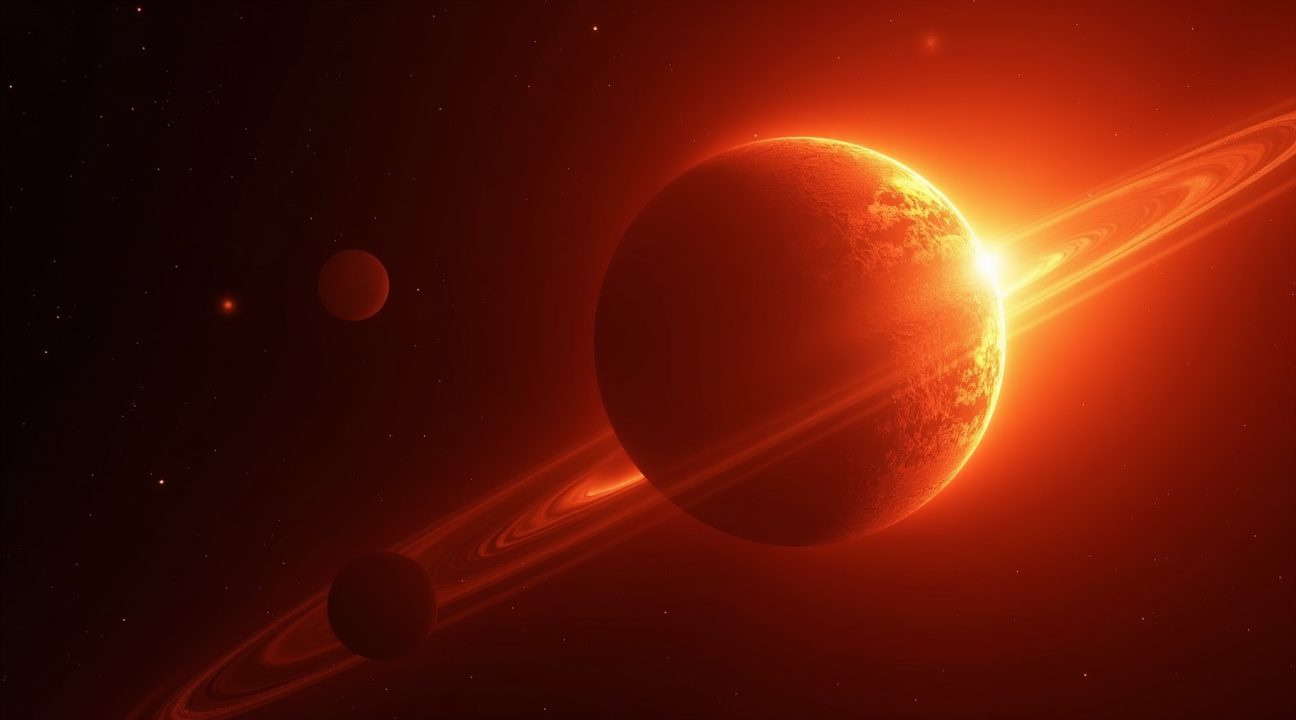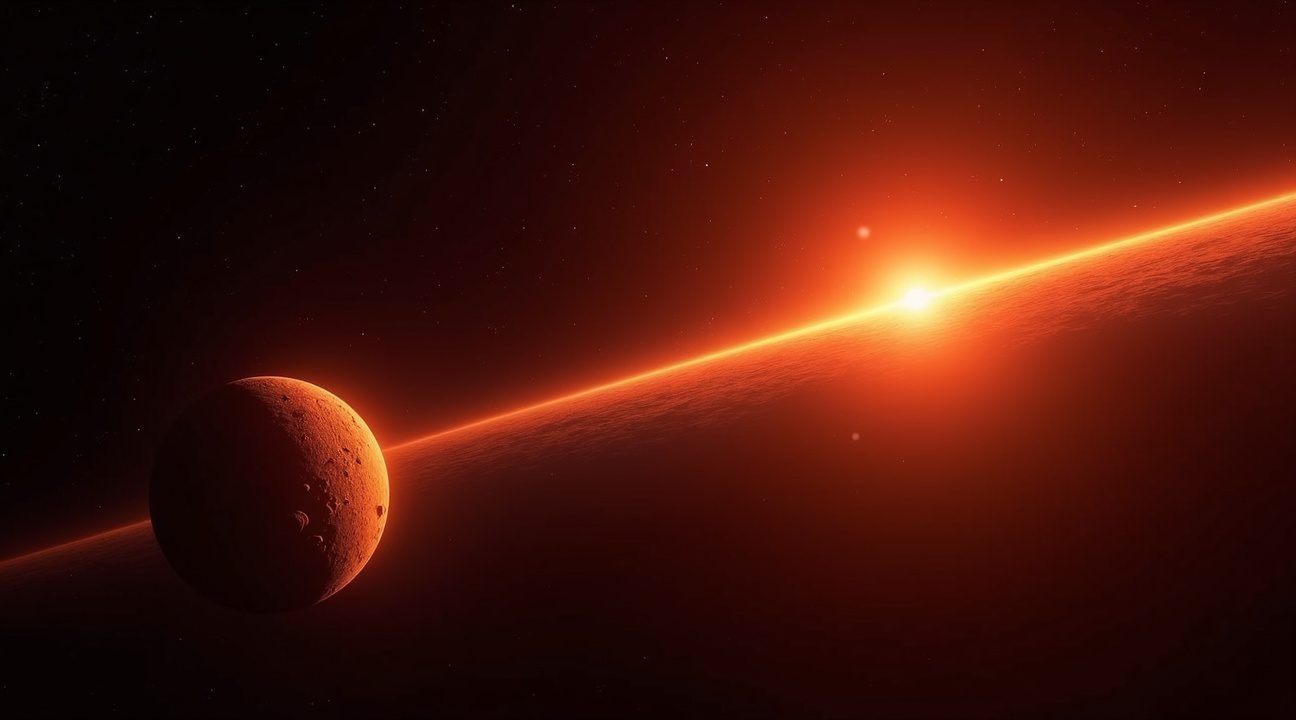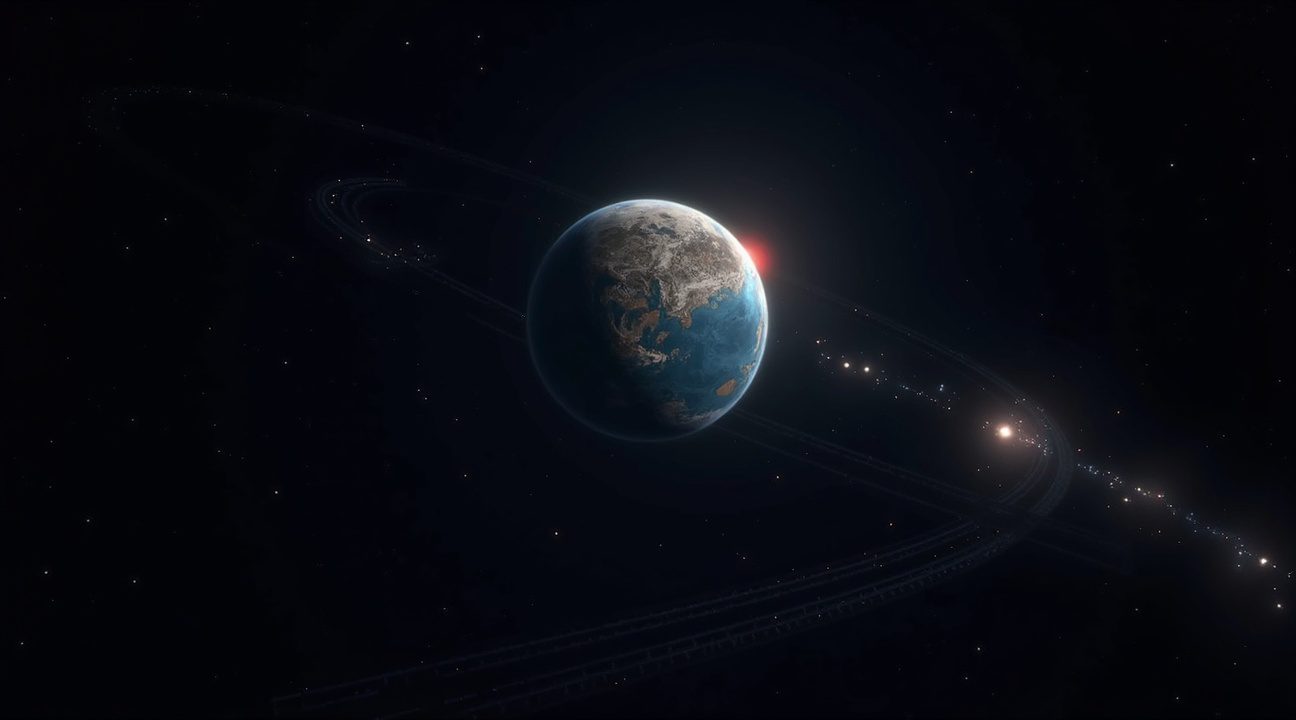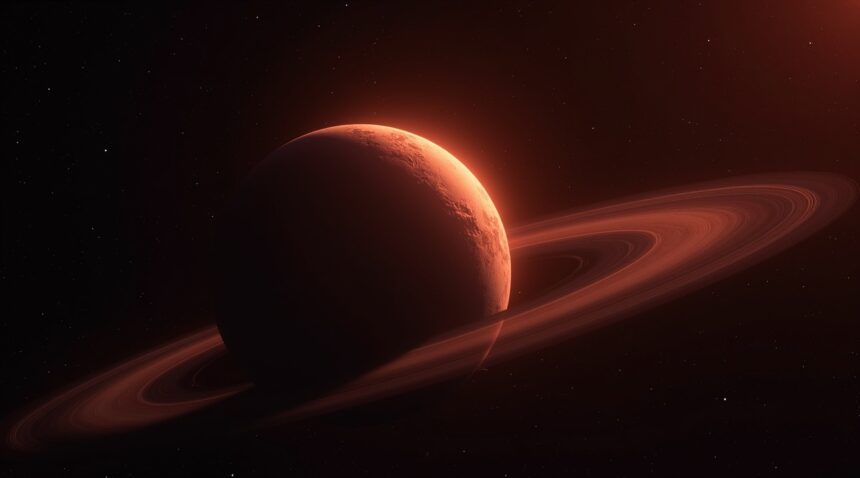The Hubble Space Telescope has confirmed that LTT 1445Ac, located just 22 light-years away, measures exactly 1.07 times Earth’s diameter and represents the closest known Earth-sized planet with perfect transit geometry for atmospheric studies. This finding offers scientists a rare opportunity to study how rocky planets might rebuild their atmospheres after losing them to intense stellar radiation, potentially transforming our understanding of planetary atmospheric evolution.
Key Takeaways
- LTT 1445Ac is the nearest confirmed Earth-sized planet that transits its host star, making it an excellent target for in-depth atmospheric analysis via transmission spectroscopy techniques.
- Hubble’s precise measurements resolved prior uncertainties about the planet’s true size, confirming it as Earth-sized rather than misclassified due to a grazing transit scenario.
- The planet’s surface temperature is around 500°F, producing harsh environmental conditions that challenge traditional atmospheric models, though its Earth-like gravity might still support an atmosphere.
- Advanced telescopes like the James Webb Space Telescope can now scan for important atmospheric components such as carbon dioxide, water vapor, and sulfur compounds—potential signs of geological activity or atmospheric regeneration.
- This discovery shows the impact of collaborative telescope missions, where TESS identifies suitable candidates, Hubble delivers accurate measurements, and Webb explores atmospheric details.
To learn more about this extraordinary exoplanetary discovery and the role of Hubble in it, visit NASA’s official website for more in-depth updates and mission details.
Hubble Confirms Earth-sized World Just 22 Light-Years Away with Perfect Transit Geometry
I find it remarkable that Hubble’s precise measurements have confirmed LTT 1445Ac measures exactly 1.07 times Earth’s diameter, solidifying its classification as a true Earth-sized rocky exoplanet. This minor size difference makes the planet virtually identical to our home world in terms of scale, representing a significant milestone in exoplanet research. The confirmation transforms what was previously a candidate world into a verified Earth analog in size.
Located just 22 light-years from our solar system, LTT 1445Ac holds the distinction of being the nearest known Earth-sized planet that transits its host star. This transit geometry creates an incredibly valuable research opportunity, as scientists can study the planet’s atmosphere when it passes between Earth and its star. The positioning allows telescopes to analyze starlight filtering through any potential atmosphere, providing insights into atmospheric composition and dynamics.
Surface Conditions and Physical Properties
The planet’s surface temperature reaches approximately 500 degrees Fahrenheit, creating conditions far too extreme for life as scientists currently understand it. Despite this inhospitable heat, the world’s Earth-like dimensions mean it likely possesses approximately the same surface gravity as our planet. This gravitational similarity could influence how any atmosphere behaves and evolves over time.
NASA’s Transiting Exoplanet Survey Satellite (TESS) originally discovered LTT 1445Ac in 2022, identifying it as a promising candidate for detailed study. Hubble’s follow-up observations provided the precision measurements necessary to confirm its Earth-sized status. The combined data from both missions establishes LTT 1445Ac as the closest example of a transiting Earth-sized exoplanet available for comprehensive analysis.
Scientists consider the planet’s transit geometry particularly fortuitous because it enables continuous monitoring of atmospheric changes over time. This positioning allows researchers to track potential atmospheric evolution, including the possibility of atmospheric rebuilding processes that might occur on rocky worlds. The precision of Hubble’s measurements ensures that future observations will have a solid baseline for comparison.
The discovery adds to growing evidence that Earth-sized rocky planets exist throughout our galactic neighborhood. LTT 1445Ac’s proximity makes it an ideal target for next-generation telescopes, which could potentially detect subtle atmospheric signatures that current instruments cannot resolve. Its status as the nearest transiting Earth-sized world positions it as a priority target for atmospheric studies.
Temperature measurements suggest the planet receives intense stellar radiation, likely stripping away lighter atmospheric components over geological timescales. However, the world’s size and gravity could enable it to retain heavier atmospheric elements or potentially regenerate its atmosphere through geological processes. Scientists theorize that rocky planets of this size might experience multiple atmospheric evolution cycles throughout their lifetimes.
The confirmation of LTT 1445Ac’s Earth-like proportions provides astronomers with a nearby laboratory for studying planetary formation and atmospheric dynamics. Unlike distant exoplanets that require extensive observation time to gather basic data, this world’s proximity enables detailed characterization studies. Future missions could potentially detect seasonal variations, weather patterns, or even signs of geological activity through careful monitoring of atmospheric changes.
Research teams plan to continue monitoring LTT 1445Ac using both ground-based and space-based telescopes to build a comprehensive picture of its atmospheric properties. The planet’s perfect alignment for transit observations ensures that scientists will have regular opportunities to study its characteristics as technology improves. This combination of proximity, size similarity to Earth, and optimal viewing geometry makes LTT 1445Ac one of the most scientifically valuable exoplanets discovered to date.

Advanced Space Telescopes Solve Critical Measurement Mystery
TESS initially spotted LTT 1445Ac, but its limitations became apparent when scientists needed precise measurements of this fascinating exoplanet. The space telescope lacked the optical resolution required to determine exactly how the planet crosses its star’s disk during transit observations.
Overcoming the Grazing Transit Challenge
Scientists faced a significant measurement problem known as a ‘grazing transit’ scenario. This occurs when a planet only partially crosses the star’s disk rather than making a complete passage. Such geometry creates a deceptive observation that would cause researchers to drastically underestimate the planet’s true diameter.
The implications of this measurement error would have been substantial. Without accurate size data, scientists couldn’t properly assess whether this Earth-sized planet truly fits the profile for atmospheric rebuilding. Incorrect diameter measurements would have skewed calculations about the planet’s density, composition, and potential for retaining gases.
Hubble’s Precision Delivers the Answer
The Hubble Space Telescope’s superior optical capabilities provided the solution to this measurement dilemma. Unlike TESS, Hubble possesses the resolution needed to distinguish between partial and complete planetary transits across the star’s surface.
Emily Pass from the Center for Astrophysics | Harvard & Smithsonian led the breakthrough research that confirmed LTT 1445Ac’s actual size. Her team’s observations revealed that the planet makes a normal transit, fully traversing the face of its host star. This confirmation eliminated the grazing transit possibility and validated the planet’s Earth-like dimensions.
Pass emphasized the critical nature of this discovery, stating that there was a genuine possibility the system had an unfortunate geometry that would prevent accurate measurements. However, Hubble’s advanced capabilities allowed the team to nail down the planet’s precise diameter with confidence.
This measurement accuracy proves essential for understanding whether LTT 1445Ac can indeed rebuild its atmosphere. The confirmed Earth-like size suggests the planet has the right gravitational pull and surface conditions to potentially retain atmospheric gases over time. Scientists studying potentially habitable worlds recognize that accurate planetary measurements serve as the foundation for all subsequent atmospheric modeling.
The collaboration between TESS and Hubble demonstrates how different space telescopes complement each other’s capabilities:
- TESS excels at detecting exoplanets across vast areas of sky.
- Hubble provides the detailed follow-up observations necessary for precise characterization.
This partnership approach continues to revolutionize exoplanet science.
The successful measurement of LTT 1445Ac also validates techniques that will prove valuable for studying other potentially habitable worlds. As researchers continue investigating whether extraterrestrial life might exist elsewhere in the universe, accurate planetary measurements remain fundamental to identifying candidates worthy of detailed atmospheric analysis.
This breakthrough highlights how technological advances in space-based telescopy continue pushing the boundaries of exoplanet science. The precise diameter confirmation for LTT 1445Ac opens new possibilities for understanding atmospheric evolution on rocky planets beyond our solar system. Such discoveries inch scientists closer to answering fundamental questions about planetary formation and the potential for life beyond Earth, much like ongoing research into whether we can recreate life from ancient DNA here on our own planet.
Rocky World Opens Door for Atmospheric Detective Work
The perfect orbital alignment of LTT 1445Ac creates an exceptional opportunity for scientists to peer into the planet’s potential atmosphere using advanced detection methods. I find this transit configuration particularly exciting because it allows researchers to employ transmission spectroscopy, a powerful technique that transforms distant starlight into atmospheric fingerprints.
How Transmission Spectroscopy Reveals Planetary Secrets
Transmission spectroscopy operates on an elegant principle that turns the parent star into a cosmic flashlight. As the planet passes between its star and Earth, starlight filters through any existing atmosphere before reaching our telescopes. Different molecules absorb specific wavelengths of light, creating unique spectral signatures that act like molecular barcodes. Scientists can identify water vapor, carbon dioxide, methane, and other atmospheric components by analyzing which wavelengths disappear from the starlight spectrum.
The rocky composition of LTT 1445Ac makes this world particularly intriguing for atmospheric studies. Unlike gas giants where thick hydrogen envelopes dominate observations, rocky planets offer clearer windows into secondary atmospheric processes. I consider this planet’s Earth-like size crucial because it suggests similar gravitational conditions that could potentially support atmospheric retention, despite the challenging thermal environment.
Temperature Challenges and Atmospheric Possibilities
The estimated 500°F surface temperature presents a fascinating puzzle for atmospheric scientists. This extreme heat challenges conventional models about atmospheric stability on rocky worlds, yet it doesn’t necessarily rule out the possibility of atmospheric presence. Venus maintains a thick atmosphere despite surface temperatures exceeding 800°F, demonstrating that rocky planets can sustain substantial atmospheric envelopes under intense thermal conditions.
Future observations using next-generation space telescopes could detect several key atmospheric indicators on LTT 1445Ac:
- Carbon dioxide would appear as the most likely candidate for detection, given its stability at high temperatures and strong spectral signatures.
- Water vapor, though less probable due to the extreme heat, could still exist in the upper atmosphere or indicate ongoing atmospheric outgassing processes.
- The presence of sulfur compounds might suggest volcanic activity contributing to atmospheric renewal.
The precise measurements of LTT 1445Ac’s size and rocky nature establish it as an outstanding target for upcoming atmospheric surveys. Unlike planets where composition remains uncertain, this world’s confirmed rocky structure allows scientists to focus specifically on secondary atmosphere detection rather than sorting through complex primary atmospheric signals. This clarity makes it an ideal laboratory for understanding how essential building blocks might survive in extreme planetary environments.
Scientists anticipate that studying this planet’s atmospheric properties could revolutionize understanding of atmospheric evolution on rocky worlds. The potential for a rebuilt atmosphere offers insights into planetary resilience and the conditions necessary for atmospheric regeneration. These findings could inform searches for habitability around other stars and enhance our knowledge of how planetary atmospheres respond to stellar radiation over cosmic timescales.
The transit geometry also enables precise atmospheric thickness measurements, should an atmosphere exist. By comparing the planet’s radius during transit at different wavelengths, researchers can determine how much starlight the atmosphere blocks at various spectral bands. This technique provides direct measurements of atmospheric scale height and composition gradients, offering unprecedented detail about the planet’s atmospheric structure.
Researchers expect that atmospheric detection attempts will push the boundaries of current observational capabilities. The challenging nature of detecting thin atmospheres on hot rocky planets requires extremely precise measurements and sophisticated data analysis techniques. Success with LTT 1445Ac would validate methodologies for studying similar worlds and expand the catalog of atmospherically active rocky exoplanets available for detailed characterization.

Exoplanet Discovery Boom Reaches New Milestone
I’ve witnessed an extraordinary acceleration in exoplanet discoveries that continues to reshape our understanding of planetary systems. As of September 2024, NASA has officially confirmed more than 6,000 exoplanets, representing a dramatic increase from the 5,000 confirmed worlds documented just three years earlier. This remarkable surge demonstrates the exponential pace at which modern exoplanet science operates, driven by advanced detection technologies and refined observation techniques.
Recent Breakthrough Discoveries
The latest findings reveal fascinating diversity among Earth-sized worlds in our cosmic neighborhood. Recent discoveries include the intriguing Earth-sized Gliese 12 b and Barnard’s Star b, positioned just six light-years away from our solar system. These nearby planets offer unprecedented opportunities for detailed study and atmospheric analysis.
LTT 1445Ac emerges as particularly significant among these recent discoveries. This nearby, transiting, Earth-sized world provides scientists with optimal conditions for comprehensive characterization. Its strategic positioning allows researchers to observe planetary transits directly, enabling precise measurements of atmospheric composition and structure. Combined with planets like Gliese 12 b, these discoveries illuminate both the diversity and frequency of terrestrial exoplanets throughout our galactic neighborhood.
Advanced Observational Programs
The TRAPPIST-1 system continues capturing scientific attention as a focal point for intensive study. The James Webb Space Telescope actively observes several potentially habitable planets within this system, searching for atmospheric signatures that might indicate conditions suitable for life. These observations represent a new era in exoplanet research, where scientists can analyze atmospheric compositions with unprecedented precision.
I find these developments particularly exciting because they demonstrate how technological advances enable deeper exploration of life-building blocks throughout the galaxy. Each new discovery adds pieces to the puzzle of planetary formation and evolution, while expanding our catalog of worlds that might harbor conditions similar to Earth. The rapid pace of confirmations suggests that thousands more exoplanets await discovery, potentially including worlds that could fundamentally change our perspective on life’s prevalence in the universe.
Multi-Telescope Approach Revolutionizes Planetary Science
The coordination between multiple space telescopes has fundamentally transformed how astronomers study exoplanets, creating an unprecedented systematic approach to planetary discovery and characterization. This collaborative framework allows scientists to gather comprehensive data that no single instrument could provide alone.
Hubble’s specialized ultraviolet capabilities serve as a cornerstone in this multi-telescope strategy, delivering precise measurements of planetary size and transit geometry that form the foundation for further investigation. The telescope’s UV sensors can detect subtle variations in starlight as planets pass in front of their host stars, providing accurate determinations of planetary radius and orbital characteristics.
The James Webb Space Telescope has revolutionized atmospheric analysis through its high-resolution infrared spectroscopy capabilities. While Hubble excels at detecting and measuring planets, Webb’s advanced infrared instruments can peer deep into planetary atmospheres, revealing temperature profiles, chemical composition, and atmospheric dynamics with extraordinary detail. This infrared perspective complements Hubble’s ultraviolet observations, creating a more complete picture of distant worlds.
TESS operates as the primary discovery engine in this coordinated effort, continuously scanning vast regions of space to identify new planetary candidates. The telescope’s wide-field surveys detect thousands of potential exoplanets through the transit method, creating a steady stream of targets for follow-up observations by more specialized instruments.
Comprehensive Planetary Characterization Through Telescope Coordination
The systematic pipeline that emerges from this multi-telescope approach follows a logical progression that maximizes scientific return. Scientists can apply this coordinated strategy to study everything from life-building blocks in distant atmospheres to potential signs of biological activity.
The process typically unfolds through these key stages:
- TESS identifies planetary candidates through initial transit detection
- Hubble provides detailed verification and precise physical measurements using ultraviolet observations
- Webb conducts comprehensive atmospheric studies through infrared spectroscopy
- Additional ground-based and space-based instruments contribute specialized measurements as needed
This layered methodology ensures that each telescope contributes its unique strengths while building upon observations from other platforms. Hubble’s ultraviolet data establishes the fundamental parameters, while Webb’s infrared instruments expand scientific understanding of atmospheric properties, thermal characteristics, and chemical composition.
The revolutionary aspect of this approach lies in its ability to validate discoveries systematically while extracting maximum scientific value from each observation. Scientists can now move from initial detection through detailed characterization with confidence, knowing that multiple independent measurements support their findings. This coordinated effort has opened new possibilities for understanding planetary formation, atmospheric evolution, and potentially even the conditions necessary for life beyond our solar system.
Why This Discovery Matters for Future Exploration
LTT 1445Ac stands as a remarkable milestone that fundamentally changes how scientists approach the study of Earth-sized exoplanets. Its rocky composition and Earth-like surface gravity establish it as a critical benchmark for understanding planetary formation processes and atmospheric retention mechanisms across the galaxy. This discovery provides researchers with a rare opportunity to examine how small, terrestrial worlds develop and potentially sustain their atmospheric envelopes over time.
Perfect Conditions for Advanced Study
The planet’s perfect transit alignment creates ideal observational conditions that make it an exceptional target for both current and future telescopes. When LTT 1445Ac passes directly between its star and Earth, instruments can analyze the starlight filtering through any potential atmosphere, revealing its chemical composition and density. This geometric advantage allows for precise measurements that would be impossible with planets that don’t transit from our perspective.
Future space missions will benefit enormously from this discovery, as LTT 1445Ac offers a controlled environment for testing new atmospheric detection techniques. The planet’s proximity to Earth, combined with its favorable orbital orientation, makes it an ideal proving ground for instruments designed to search for signs of life on distant worlds. These capabilities could eventually help scientists identify essential building blocks for life on other planetary bodies.
Multi-Telescope Coordination Strategies
The ongoing analysis of the TRAPPIST-1e system demonstrates how coordinated observation campaigns using multiple telescopes represent one of our most powerful tools for identifying potentially habitable exoplanets. This collaborative approach combines data from ground-based observatories with space-based instruments, creating a comprehensive picture of distant worlds that no single telescope could achieve alone.
LTT 1445Ac’s discovery validates this multi-platform strategy and establishes protocols for future investigations. Scientists can now apply these proven techniques to study other candidate planets, building a systematic approach to exoplanet characterization. The methods developed through this research will be essential for upcoming missions like the James Webb Space Telescope’s extended observations and the next generation of ground-based extremely large telescopes.
The discovery also highlights the importance of long-term monitoring programs that track planetary systems over extended periods. Just as researchers have found evidence of undiscovered species in remote locations on Earth, systematic exoplanet surveys continue to reveal unexpected worlds that challenge our understanding of planetary science.
This finding represents the next great chapter in exoplanetary science, establishing crucial groundwork for future missions and investigations into distant Earth-like worlds. The techniques and insights gained from studying LTT 1445Ac will directly inform the design of next-generation space telescopes and detection systems. Scientists can now refine their models of atmospheric evolution and test theories about how planets maintain or lose their protective gas envelopes over billions of years.
The implications extend beyond pure scientific curiosity. Understanding how atmospheres form and persist on Earth-sized planets directly relates to humanity’s long-term survival prospects and potential expansion beyond our solar system. While some researchers explore whether aliens have been here on Earth for extended periods, discoveries like LTT 1445Ac focus our attention on identifying worlds that could support life as we know it.
The planet’s characteristics also provide valuable data for comparing different types of planetary evolution. Unlike the ambitious but currently impossible task of attempting to recreate dinosaurs from DNA, studying LTT 1445Ac offers realistic opportunities to understand how life-supporting conditions develop and persist on rocky worlds. This research will guide future space exploration priorities and help scientists determine which exoplanets deserve the most intensive study with limited observational resources.

Sources:
NASA – “NASA Hubble Measures the Size of the Nearest Transiting Earth-Sized Planet”
Wikipedia – “Discoveries of exoplanets”
MIT News – “Study finds exoplanet TRAPPIST-1e unlikely to have a Venus-like atmosphere”
ESA/Hubble – “NASA/ESA Hubble Space Telescope News Release HEIC2025”
NASA Webb – “Webb Looks at Earth-Sized Habitable-Zone Exoplanet TRAPPIST-1e”
Space.com – “6,000 Exoplanets Discovered”

